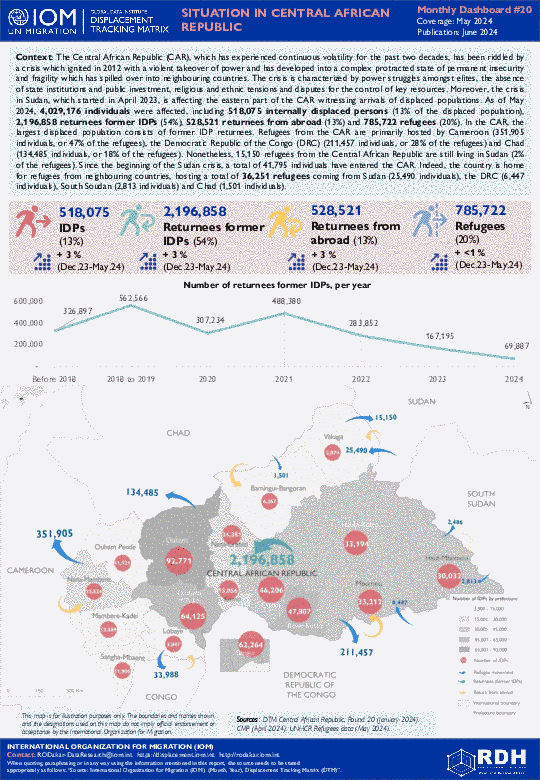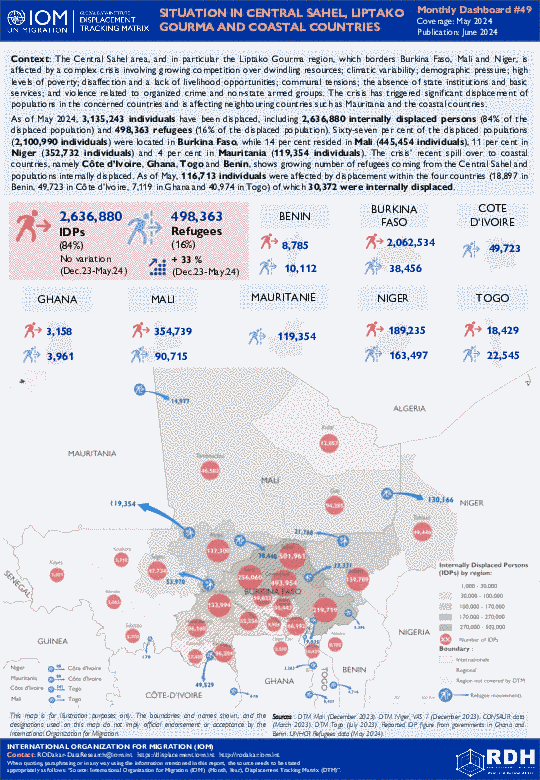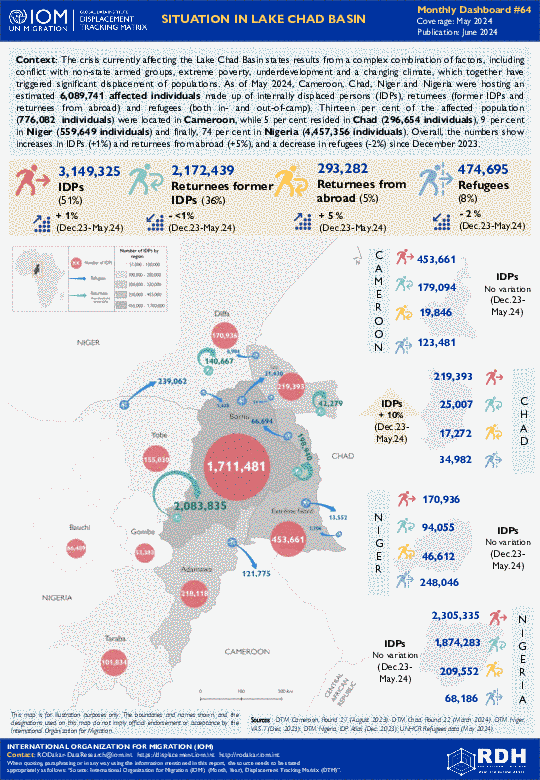-
Countries
-
Data and Analysis
-
Special Focus
-
Crisis Responses
Internal displacement
Domain host
displacement.iom.int

Contact
DTM Europe, DTMMediterranean@iom.int
Language
English
Location
Slovakia
Period Covered
Jan 01 2024
Mar 31 2024
Activity
- Survey
- Return Intention
- Flow Monitoring
IOM’s Displacement Tracking Matrix (DTM) collected data on Ukrainian nationals and Third-Country Nationals (TCNs) that crossed back to Ukraine from or through Slovakia, either temporarily or permanently. The survey focuses on the return intentions, duration of displacement, destinations, assistance, and experiences of discrimination of respondents. A total of 1,335 surveys were collected between January and March 2024.
Key findings:
- 27% of Ukrainian respondents intend to stay in Ukraine (prospective returnees), while 68% plan to go for a short visit.
- The share of those intending to return to Ukraine is higher among men than women (49% vs 25%). Women are more likely to be crossing into Ukraine for a short visit than men (69% vs 44%).
- Most of the short-term visitors plan to stay in their own home in Ukraine (78% overall), while others report to be going to their relatives’ homes (10%), finding other private solutions (7%) or staying with friends (4%). The share of those planning to stay at home is higher among prospective returnees (98%) than among short-term visitors (78%).
- Reasons for returning for prospective returnees include: visit relatives or close friends (75%), meet with family members (6%), reunite with their family (6%).
- Reasons for returning for short-term visitors include: visit family members (76%), healthcare (26%), reunite with family (21%).
- 64% of the Ukrainian nationals originate from seven regions in Ukraine: Zakarpatska (21%), Kyiv (13%), Kharkivska (8%), Dnipropetrovska (8%), Odeska (6%), Zaporizka (3%), and Mykolaivska (3%). The remaining 36% of respondents come from another 20 regions across Ukraine.
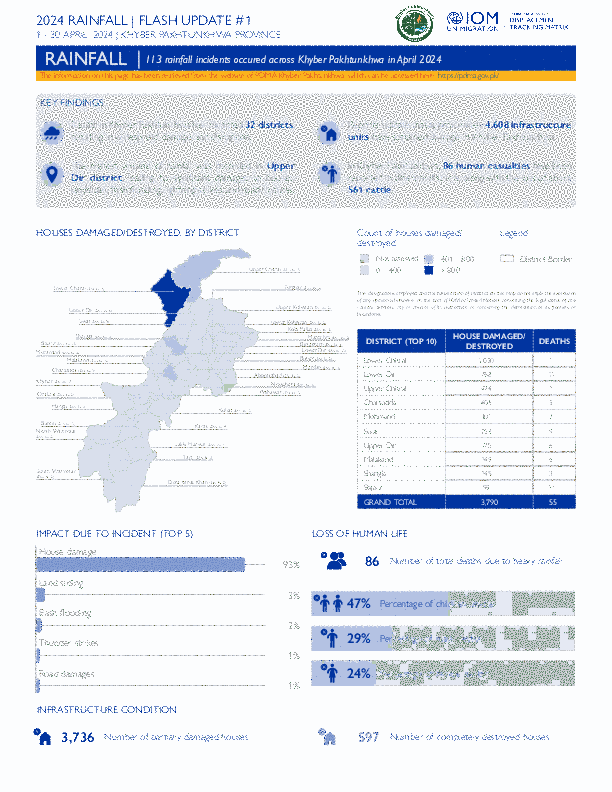
Contact
DTMPakistan@iom.int
Language
English
Location
Pakistan
Period Covered
Apr 01 2024
Apr 30 2024
Activity
- Event Tracking
Rainfall in Khyber Pakhtunkhwa has impacted 32 districts, resulting in widespread damage and disruption. Reports indicate that approximately 4,608 infrastructure units have sustained damage in Khyber Pakhtunkhwa. The highest volume of rainfall was recorded in Upper Dir district, leading to significant damages to houses, landslides, flash flooding, lightning strikes, and road closures. In Khyber Pakhtunkhwa, 86 human casualties have been reported in different districts, along with the loss of about 561 cattle.
The Central African Republic (CAR), which has experienced continuous volatility for the past two decades, has been riddled by a crisis which ignited in 2012 with a violent takeover of power and has developed into a complex protracted state of permanent insecurity and fragility which has spilled over into neighbouring countries. The crisis is characterized by power struggles amongst elites, the absence of state institutions and public investment, religious and ethnic tensions and disputes for the control of key resources. Moreover, the crisis in Sudan, which started in April 2023, is affecting the eastern part of the CAR witnessing arrivals of displaced populations.
As of May 2024, 4,029,176 individuals were affected, including 518,075 internally displaced persons (13% of the displaced population), 2,196,858 returnees former IDPs (54%), 528,521 returnees from abroad (13%) and 785,722 refugees (20%). In the CAR, the largest displaced population consists of former IDP returnees. Refugees from the CAR are primarily hosted by Cameroon (351,905 individuals, or 47% of the refugees), the Democratic Republic of the Congo (DRC) (211,457 individuals, or 28% of the refugees) and Chad (134,485 individuals, or 18% of the refugees). Nonetheless, 15,150 refugees from the Central African Republic are still living in Sudan (2% of the refugees). Since the beginning of the Sudan crisis, a total of 41,795 individuals have entered the CAR. Indeed, the country is home for refugees from neighbouring countries, hosting a total of 36,251 refugees coming from Sudan (25,490 individuals), the DRC (6,447 individuals), South Soudan (2,813 individuals) and Chad (1,501 individuals).
The Central Sahel area, and in particular the Liptako Gourma region, which borders Burkina Faso, Mali and Niger, is affected by a complex crisis involving growing competition over dwindling resources; climatic variability; demographic pressure; high levels of poverty; disaffection and a lack of livelihood opportunities; communal tensions; the absence of state institutions and basic services; and violence related to organized crime and non-state armed groups. The crisis has triggered significant displacement of populations in the concerned countries and is affecting neighbouring countries such as Mauritania and the coastal countries.
As of May 2024, 3,135,243 individuals have been displaced, including 2,636,880 internally displaced persons (84% of the displaced population) and 498,363 refugees (16% of the displaced population). Sixty-seven per cent of the displaced populations (2,100,990 individuals) were located in Burkina Faso, while 14 per cent resided in Mali (445,454 individuals), 11 per cent in Niger (352,732 individuals) and 4 per cent in Mauritania (119,354 individuals). The crisis’ recent spill over to coastal countries, namely Côte d’Ivoire, Ghana, Togo and Benin, shows growing number of refugees coming from the Central Sahel and populations internally displaced. As of May, 116,713 individuals were affected by displacement within the four countries (18,897 in Benin, 49,723 in Côte d’Ivoire, 7,119 in Ghana and 40,974 in Togo) of which 30,372 were internally displaced.
The crisis currently affecting the Lake Chad Basin states results from a complex combination of factors, including conflict with non-state armed groups, extreme poverty, underdevelopment and a changing climate, which together have triggered significant displacement of populations.
As of May 2024, Cameroon, Chad, Niger and Nigeria were hosting an estimated 6,089,741 affected individuals made up of internally displaced persons (IDPs), returnees (former IDPs and returnees from abroad) and refugees (both in- and out-of-camp). Thirteen per cent of the affected population (776,082 individuals) were located in Cameroon, while 5 per cent resided in Chad (296,654 individuals), 9 per cent in Niger (559,649 individuals) and finally, 74 per cent in Nigeria (4,457,356 individuals). Overall, the numbers show increases in IDPs (+1%) and returnees from abroad (+5%), and a decrease in refugees (-2%) since December 2023.
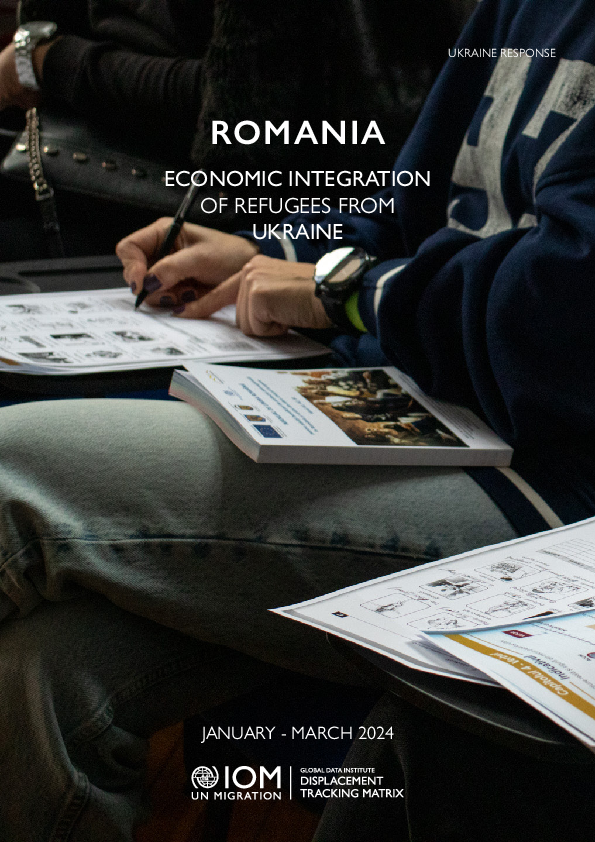
Contact
DTM Europe, DTMMediterranean@iom.int
Language
English
Location
Romania
Period Covered
Jan 01 2024
Mar 31 2024
Activity
- Survey
- Flow Monitoring
IOM’s Displacement Tracking Matrix (DTM) collected data through Surveys with Refugees in the Ukraine Response region from January to March 2024. This report focuses on the economic integration of the Ukrainian nationals residing in Romania since the start of the war in February 2022. The survey reported on the situation of 436 interviewed Ukrainian nationals, with a focus on the respondents of working age (18-64 years old).
Key findings:
- 60% of respondents were active in the labour market, while 35% were inactive and 5% were unknown
- Within the active population, 65% were employed and 35% were unemployed and looking for a job
- Most respondents utilised their personal network to find employment (43%). Others utilised: recruitment agencies (19%), social media (14%), job portals (11%).
- 43% of respondents had neutral feelings towards their job satisfaction
- Majority of respondents identified no problems at work (51%). For those who did, the main problems included: being underpaid (4%), having no contract (4%), working long hours (4%), and no breaks (3%).
- Top 3 sources for paying expenses included: family support (46%), income (41%), and savings (35%).
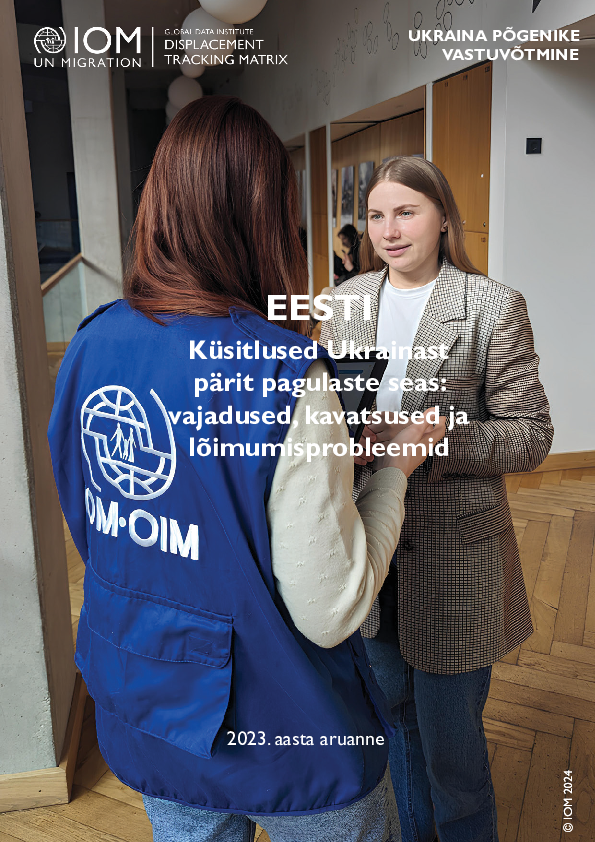
Contact
DTM Europe, DTMMediterranean@iom.int
Language
Estonian
Location
Estonia
Period Covered
Mar 01 2023
Dec 31 2023
Activity
- Survey
- Flow Monitoring
IOMi sundrände jälgimise maatriks on regulaarselt küsitlenud inimesi, kes elavad 11 riigis, mida hõlmab Ukraina piirkondliku pagulasküsimuse tegevuskava. Küsitluse eesmärk on parandada arusaamist nende profiilidest, sundrändemustritest, kavatsustest ja vajadustest. Küsitlust tehakse kuues Ukraina naaberriigis –Valgevenes, Ungaris, Poolas, Moldova Vabariigis, Rumeenias ja Slovakkias –ning viies teises Euroopa riigis, mida Ukrainast pärit pagulaste saabumine alates sõja algusest 2022. aasta veebruaris iseäranis mõjutab, sealhulgas Bulgaarias, Tšehhis, Eestis, Lätis ja Leedus.
Käesolevas aruandes esitatud analüüs põhineb 2023. aasta märtsist detsembrini kogutud iga-aastastel andmetel.

Contact
iomtashkent@iom.int
Language
English
Location
Uzbekistan
Period Covered
Oct 01 2023
Dec 31 2023
Activity
- Flow Monitoring Survey
- Mobility Tracking
Ushbu hisobot 2023-yil oktabr-dekabr oylari uchun mavjud ochiq maʼlumotlarga asoslanib, O‘zbekistondagi migratsiya muammolariga oid so‘nggi jarayonlar bo‘yicha maʼlumotlarni taqdim etadi hamda jamoatchilikka ochiq bo‘lgan milliy va xalqaro maʼlumotlar to‘plami asosida butun o‘tgan yil uchun migratsiya jarayonlariga oid asosiy xulosalarni keltiradi. Hisobot mamlakatdagi migratsiya vaziyatiga sezilarli ta’sir ko‘rsatgan so‘nggi yirik global va mintaqaviy voqealarni o‘z ichiga oladi. Rossiyaning Ukrainaga bosqini davom etishi hamda buning natijasida an’anaviy migratsiya yo‘laklari, mehnat migratsiyasi oqimining o‘zgarishi, iqlim o‘zgarishi va migratsiya xavotirlarining kuchayishi, o‘sib borayotgan urbanizatsiya jarayoni, ijtimoiy-iqtisodiy sharoitlar, tartibsiz migratsiya jarayonlarining kuchayishi va boshqa muhim voqealar mamlakatdagi ushbu davrda insonlar mobilligi va migratsiya harakatining asosiy omili sifatida tavsiflangan. Shuningdek, hisobot ushbu davrda O‘zbekistonda IOM tomonidan taqdim etilgan migratsiya ma’lumotlari bo‘yicha malaka oshirish sessiyalari haqida to‘xtalib, mazkur yo‘nalishdagi sa’yi-harakatlarni yoritadi.

Contact
DTMAfghanistan@iom.int
Language
English
Location
Afghanistan
Period Covered
Jan 01 2023
Dec 31 2023
Activity
- Survey
Following the release of the first edition of PROGRESS 2023 report, the Displacement Tracking Matrix (DTM) has compiled a series of National Displacement Profiles based on end of year 2023 figures. These profiles offer insights into the latest end-of-year 2023 figures, aligning with the objectives outlined by the Data for Solutions to Internal Displacement Taskforce (DSID).
The profile provides a comprehensive overview of the demographic breakdowns and geographical distribution of internally displaced persons (IDPs) in Afghanistan as of the end of 2023. It delves into the primary areas of origin and displacement for IDPs, shedding light on the factors influencing their decision-making processes regarding the selection of solutions locations. Additionally, the report discusses the obstacles encountered by IDPs in their pursuit of durable solutions.
This compilation underscores the critical role of data in addressing internal displacement challenges and highlights the ongoing efforts to leverage data-driven solutions through collaborative initiatives like DSID.
Contact
DTM Yemen, iomyemendtm@iom.int
Location
Yemen
Activity
- Mobility Tracking
- Event Tracking
Period Covered
May 26 2024 -Jun 01 2024
From 1 January to 1 June 2024, IOM Yemen DTM tracked 1,465 households (HH) (8,790 Individuals) who experienced displacement at least once.
Between 26 May and 1 June 2024, IOM Yemen DTM tracked 57 households (342 individuals) displaced at least once. The majority of people moved into/within the following governorates and districts:
- Ma’rib (38 HHs) – Ma’rib City (19 HHs), Ma’rib (14 HHs), Harib (5 HHs) districts. Most displacements in the governorate originated from Ta’iz and Al Hodeidah.
- Shabwah (8 HHs) – Bayhan (8 HHs) district. All displacements in the governorate originated from Al Bayda.
- Ta’iz (6 HHs) – Al Makha (3 HHs), Al Misrakh (2 HHs), Jabal Habashi (1 HH) districts. Most displacements in the governorate originated from Ta’iz and Al Hodeidah.
The majority of people moved from the following governorates and districts:
- Ta’iz (12 HHs) – Mawza (3 HHs), As Silw (3 HHs), Maqbanah (1 HH) districts.
- Al Hodeidah (9 HHs) – Ad Durayhimi (2 HHs), Az Zuhrah (1 HH), Jabal Ras (1 HH) districts.
- Al Bayda (8 HHs) – Numan (4 HHs), Nati (4 HHs) districts.
Population Groups
IDPs
Returnee (Previously Internally Displaced)
Survey Methodology
Unit of Analysis Or Observation
Admin Area 2
Household
Site or Location
Type of Survey or Assessment
Household
Key Informant
Keywords
Geographical Scope Partial Coverage
Administrative boundaries with available data
The current dataset covers the following administrative boundaries
Pagination
- Previous page
- Page 76
- Next page
